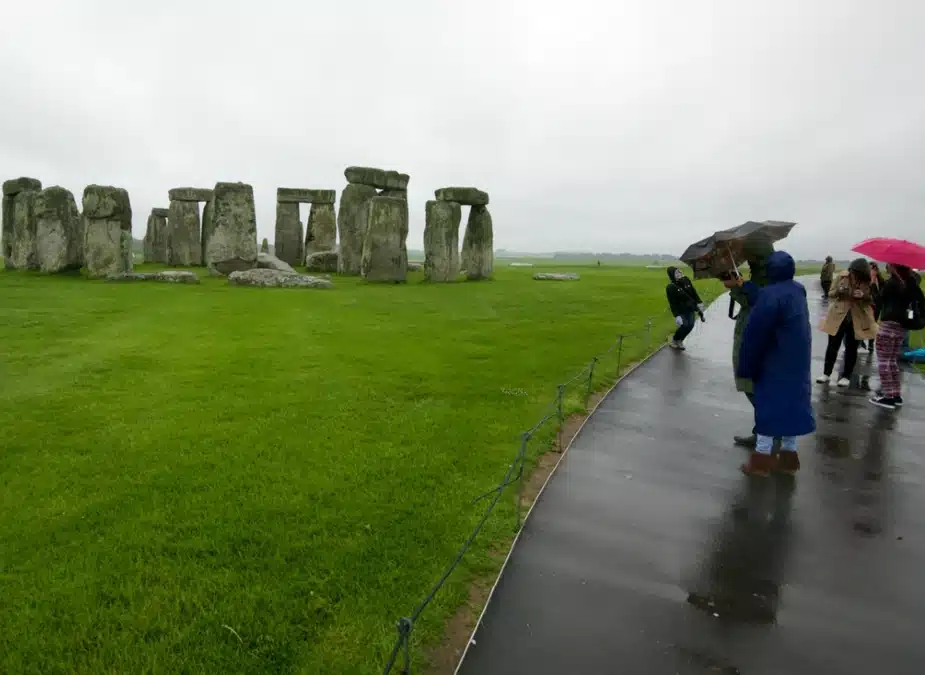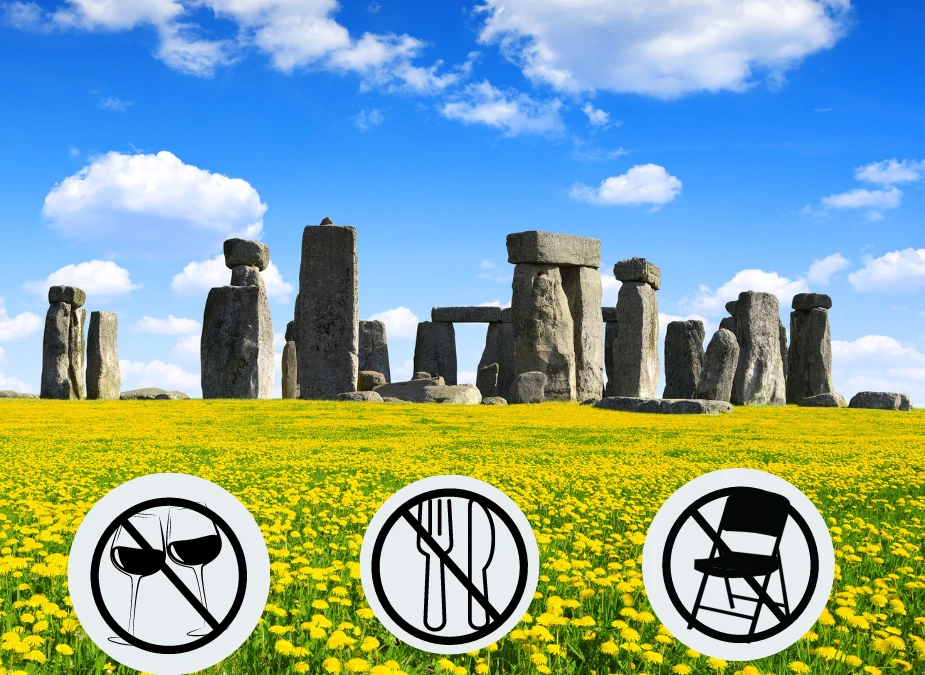Stonehenge is the world’s most famous archeological spot that millions of visitors travel to experience.
Apart from the central circular stone pieces, there are various significant stones, exhibits, trails and a visitor’s center to visit.
With centuries of history buried and portrayed, Stonehenge is a mystery that can never be forgotten.
Here are a few tips for visiting Stonehenge to get the best on this trip.
1. Plan how to visit Stonehenge in advance
There are various modes of transport to reach Stonehenge.
Tourists can take trains, buses or cars to reach Stonehenge from London, Bath, Southampton and Salisbury.
Know more about how to reach Stonehenge to plan your visit.
2. Explore Stonehenge Visitor Center
Do not forget the Visitor Center.
The Visitor Center houses exhibitions, museums, shops and more that elevate your Stonehenge experience.
3. Book your tickets in advance
There is a fixed timed entry system to visit Stonehenge.
Visitors need to buy tickets in advance to pre-book their preferred time slot.
Buying your Stonehenge tickets online before your visit is recommended to skip the hassle of long queues and any last-minute disappointments.
4. Take a guided tour

Stonehenge is a site of mystery that archeologists and historians have spent years trying to unfold.
Take a guided tour to get the best experience and understand the place you are visiting.
On a guided tour, a knowledgeable guide accompanies the tourists to help them understand the history and narrate interesting facts about the monument.
5. Plan a Day Trip from London
Visiting Stonehenge from London is a perfect day trip idea.
There are multiple options to travel from London to Stonehenge, like rail, bus and car.
In addition, visitors can also explore various historical sites on their way to Stonehenge with combination tour tickets like Windsor Castle, Bath and Lacock.
6. Carry Water and a Light Snack
Once you start touring Stonehenge, no shops are available in the vicinity.
We suggest carrying water and light refreshments to keep you hydrated and energetic throughout the tour.
7. Be Prepared for Rain

Weather conditions can greatly influence your trip, so you must be prepared beforehand.
When planning a Stonehenge trip, it is advisable to carry umbrellas and raincoats.
Remember that large umbrellas are not allowed near Stonehenge, so carry a small umbrella or raincoat if it starts raining.
8. Appropriate Clothing
Place-appropriate clothing is crucial for all trips; the same goes for Stonehenge.
While planning a trip to Stonehenge, choose comfortable clothes.
Some visitors choose to hike to the Stonehenge landmark site; therefore, wearing comfortable activewear is important.
At the same time, visitors must always remember to keep warm clothes such as jackets or windcheaters.
Layers are advisable because the weather at Stonehenge can be pretty cold and damp.
9. Comfortable Shoes
Wearing the right shoes is crucial for ensuring a comfortable trip to Stonehenge.
The car park at the site and Stonehenge itself are fields and since rain makes common appearances, it is advisable to wear shoes with proper grip to avoid slipping.
Visitors planning to hike from nearby locations should especially wear comfortable sports shoes to avoid foot strain.
Choose your pair of shoes carefully, keeping the dampness and rain in mind.
Avoid flip-flops and sandals at all costs; heels and wedges for ladies are a complete no-no.
10. Be Cautious of the Property
Stonehenge is a popular tourist destination and has survived years and centuries since it was built.
Our responsibility is to protect and preserve it for future generations.
When visiting Stonehenge, be very careful not to cause any damage to the monuments.
Avoid jumping, leaning or hanging on the stones.
Respect all necessary rules and regulations levied by the official authorities to protect the site.
11. Capture Memories
Stonehenge is an iconic historical landmark that has withstood the test of time for centuries.
Clicking pictures with the monument is highly recommended but please avoid any activities that might damage the monument.
Avoid high-flash photography and obey the rules and regulations put up by the authorities.
Vloggers and photographers should remember that Drones and other high-flying objects are prohibited at the site.
Avoid using such photography and videography tools when visiting Stonehenge.
12. No Pets
As sad as it sounds, it is important to remember that pets are prohibited on the Stonehenge site.
Dogs, cats and other pets are prohibited on the monument site inside the Stone Circle.
This rule is implied to ensure the safety of the monument and consider that fecal matter may become a nuisance for visitors walking barefoot.
An exception may be made for visitors with assistance dogs, but pets are completely prohibited.
13. Travel Light
Traveling light is the key to exploring Stonehenge.
Visitors should remember that only small bags, approximately 30cm x 25cm x 15cm, are allowed inside the Stonehenge vicinity.
Visitors should also avoid bringing valuables items like jewelry and other expensive items.
Stonehenge Administration Authorities take no responsibility for lost or damaged products in the Stonehenge monument premises and the car park.
So it is best to avoid bringing large bags and suitcases as you won’t be allowed to take them in.
What not to bring?

The Stonehenge administration authorities ensure their best efforts to secure and preserve the monument from all possible threats.
Therefore, keeping security in mind, the administration seeks visitors to avoid bringing certain items strictly.
These items are prohibited, keeping the safety and security of tourists, officials and the monument’s security in mind.
The authorities thoroughly search bags and any visitor carrying illegal or prohibited items will be refused entry.
They may also confiscate the items and refuse to return them later.
Avoid Glass Items
The Stonehenge administration clearly states visitors cannot bring glass items into the vicinity of the Stone Circle.
Glass objects include any and all objects made of glass, including wine glasses and bottles.
If you plan to picnic at Stonehenge, do not carry glass items.
This rule is in place considering many Stonehenge visitors walk barefoot and broken pieces of glass can cause them harm or injury.
Apart from human beings, livestock and wildlife graze in the Stonehenge area.
Allowing glass items can threaten them and broken glass pieces may hurt their feet, or worse, they may consume them, causing severe internal damage.
Naked Flames
The administration is very concerned about fire hazards in the vicinity that may cause potential threats to life and objects.
Naturally, visitors are prohibited from bringing items that may cause naked flames or smoke.
Keeping many visitors in mind during the solstice, naked flames pose a severe threat.
So, visitors should not light any fires and remember that lighting fires at Stonehenge are against the local bylaws.
This includes restrictions on flaming torches, candles, night lights, Chinese lanterns, fireworks and BBQs.
Guests are also restricted from smoking in the area and smudge sticks and burning incense are also prohibited.
Blades and Sharp Objects
Blades, sharp objects and pointed objects are prohibited on the premises, keeping the safety of the monuments and the visitors in mind.
This includes knives and forks for those planning to picnic.
If you bring such items, please leave them in your car before entering the Stone Circle.
Sleeping and Camping Gear
Stonehenge authorities do not permit sleeping bags or duvets for those planning to sleep or camp in Stonehenge.
Shooting ticks are prohibited, too.
Visitors can bring a ground sheet or blanket, but avoid sleeping bags, keeping security in mind.
Camping or erecting tents and BBQs are prohibited anywhere on the Stonehenge premises near the Stones, Car Park, or Visitor’s Centre.
Chairs
Visitors can bring chairs for visitors in need, but they need to ensure that the chairs are designed for outdoor use.
It is also important to note that the chairs should be placed on even ground and not driven into the ground.
Visitors bringing chairs should remember that the chairs must be placed at least 2 meters away from the standing and fallen stones at Stonehenge.
Featured Image: LoggaWiggler / pixabay (Canva)



